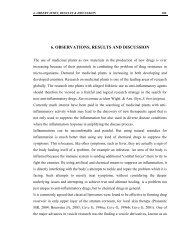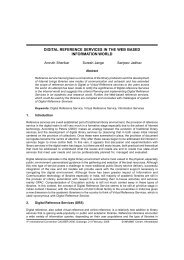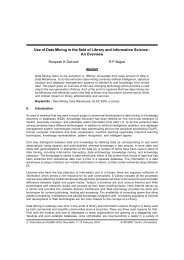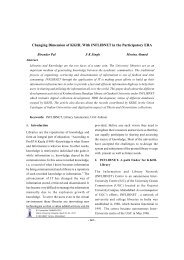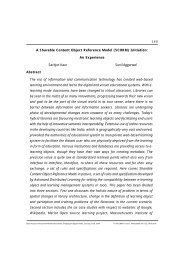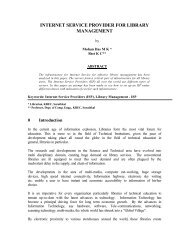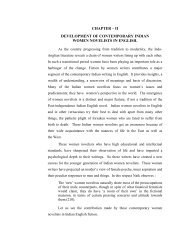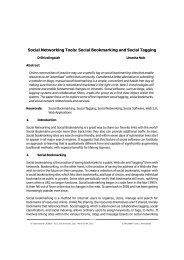Planning for Library Automation: Academic Libraries - DSpace ...
Planning for Library Automation: Academic Libraries - DSpace ...
Planning for Library Automation: Academic Libraries - DSpace ...
- No tags were found...
Create successful ePaper yourself
Turn your PDF publications into a flip-book with our unique Google optimized e-Paper software.
<strong>Planning</strong> <strong>for</strong> <strong>Library</strong> <strong>Automation</strong>: <strong>Academic</strong> <strong>Libraries</strong> 18------------------------------------------------------------------------------------------------------------------------------------------<strong>Planning</strong> <strong>for</strong> library automation has been defined as planning <strong>for</strong> "integrated systems" that computerize anarray of traditional library functions using a common database. While this is still generally true, rapidtechnological change is <strong>for</strong>cing a reexamination of what it means to "automate the library." As physical,spatial and temporal barriers to acquiring in<strong>for</strong>mation are crumbling, libraries must plan <strong>for</strong> a broader andmore comprehensive approach to providing automated services.DEVELOPING A LIBRARY "PROFILE":One of the most important planning tools involves collecting basic statistical in<strong>for</strong>mation on the libraryand its operations. You will find that the same basic data will be needed again and again -- whether <strong>for</strong>vendors from whom you are requesting cost estimates, or <strong>for</strong> other libraries with whom you may beseeking to cooperate in implementing automation.The following are examples of commonly needed data:? Number of titles and volumes in the collection, current and projected;? Number of borrowers, current and projected;? Number of materials circulated, current and projected;? Number of new materials acquired, current and projected;? Interlibrary loans, lent to and borrowed from other libraries;? Description of any cooperative arrangements involving the library; and,? <strong>Library</strong> address and hours of operation.In addition, it is important to take stock of any existing automation in the library by compiling thefollowing data:? Percentage of collection that has catalog records in machine-readable <strong>for</strong>m;? Description of collection without machine-readable records, by category (e.g. monographs,audiovisuals);? Description of currently-automated library functions (if any);? Estimates of the location and number of workstations (to show where you intend to haveequipment in any future system); and,? Specifications <strong>for</strong> any existing equipment to be re-used with any future system (if any).At the same time that this data is being assembled, it is important to assess user needs and set servicepriorities. This can be accomplished by undertaking a focused, strategic planning process designed toinvolve the library's "stakeholders."DEVELOPING A STRATEGIC PLANA library planning to automate should undertake a process by which representative staff and users canidentify service needs and objectives. The purpose of such an ef<strong>for</strong>t is to allow participants to articulatetheir interests and concerns, share perspectives and learn about possibilities in a collaborative setting.Group interaction is an important contributing factor in the success of the goal, which is to develop andsustain library automation in the years ahead.Here are the basic steps involved in this process:? Plan on a two-day, intensive planning ef<strong>for</strong>t.-----------------------------------------------------------------------------------------------------------------------------------------------------INFLIBNET Regional Training Programme in <strong>Library</strong> <strong>Automation</strong> (IRTPLA) 2004© INFLIBNET Centre, University Grants Commission, Ahmedabad-380009, India




